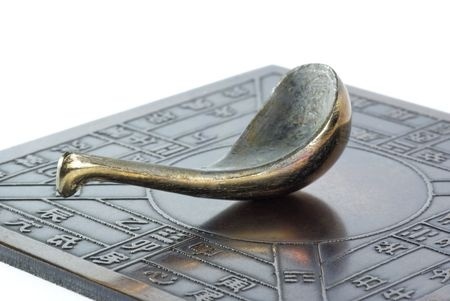Chinese Compass 指南針
Dublin Core
Title
Chinese Compass 指南針
Subject
Sailing, Direction, Navigation
Description
The compass was invented more than 2000 years ago. The Ancient Chinese compass was made from iron oxide, a mineral ore. Iron oxide is also known as lodestone and magneta.
Date
Han Dynasty (206 BC–220 AD)
Format
Metallic
Type
Craft
Crafts Item Type Metadata
Crafting Methods
The most popular style of the first Chinese compass used a lodestone (which automatically points to the south) and a bronze plate. The lodestone was carved into the shape of a spoon. The spoon was placed on a flat plate of bronze. As the bronze plate was moved, the lodestone spun around and came to a stop in a north-to-south orientation with the handle pointing to the south. The “magnetized” lodestone aligned itself with the Earth’s magnetic field. This style of compass was called a “south-pointer”. The bronze plate was also marked with constellations, cardinal points, and other symbols important to the Ancient Chinese.
Another style of compass was made by placing an iron needle that had been rubbed with a lodestone on a piece of wood and floating the wood in a bowl of water. The water allowed the wood to move or spin around until the iron oxide needle was pointing south.
Another style of compass was made by placing an iron needle that had been rubbed with a lodestone on a piece of wood and floating the wood in a bowl of water. The water allowed the wood to move or spin around until the iron oxide needle was pointing south.
Materials
Bronze, Metal, Magnet, Iron
Usage and Application
The original use of Ancient Chinese compasses was for maintaining harmony and prosperity with one’s environment and for telling the future.
Additionally, the Ancient Chinese used the compass for navigation – to find their way home when traveling. The use of the compass for travel also gave the advantage of being able to travel no matter the weather condition. If clouds or fog masked the sun or the stars, you could still travel because the compass would point you in the right direction.
Additionally, the Ancient Chinese used the compass for navigation – to find their way home when traveling. The use of the compass for travel also gave the advantage of being able to travel no matter the weather condition. If clouds or fog masked the sun or the stars, you could still travel because the compass would point you in the right direction.
Interesting Facts
One of the first recordings of using a compass for navigation was during the Northern Song dynasty (960 CE – 1126 CE). These compasses were made by floating a magnetized needle in water. The needle could move freely in the water and point to the earth’s magnetic poles no matter the movement from the ship or boat.
Collection
Citation
“Chinese Compass 指南針,” CCCH9051 Group 64, accessed January 4, 2026, https://learning.hku.hk/ccch9051/group-64/items/show/48.

